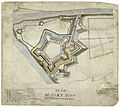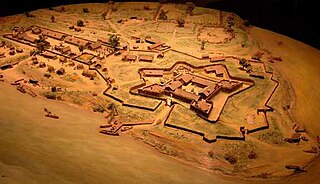
Fort Duquesne was a fort established by the French in 1754, at the confluence of the Allegheny and Monongahela rivers. It was later taken over by the British, and later the Americans, and developed as Pittsburgh in the U.S. state of Pennsylvania. Fort Duquesne was destroyed by the French before its British conquest during the Seven Years' War, known as the French and Indian War on the North American front. The British replaced it, building Fort Pitt between 1759 and 1761. The site of both forts is now occupied by Point State Park, where the outlines of the two forts have been laid in brick.

Oakland is the academic and healthcare center of Pittsburgh and one of the city's major cultural centers. Home to three universities, museums, hospitals, shopping venues, restaurants, and recreational activities, this section of the city also includes two city-designated historic districts: the mostly residential Schenley Farms Historic District and the predominantly institutional Oakland Civic Center Historic District, as well as the locally-designated Oakland Square Historic District.

A blockhouse is a small fortification, usually consisting of one or more rooms with loopholes, allowing its defenders to fire in various directions. It is usually an isolated fort in the form of a single building, serving as a defensive strong point against any enemy that does not possess siege equipment or, in modern times, artillery, air force and cruise missiles. A fortification intended to resist these weapons is more likely to qualify as a fortress or a redoubt, or in modern times, be an underground bunker. However, a blockhouse may also refer to a room within a larger fortification, usually a battery or redoubt.
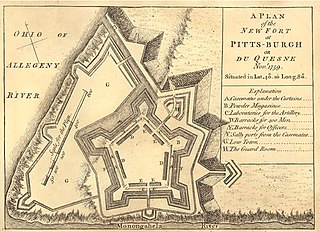
Fort Pitt was a fort built by British forces between 1759 and 1761 during the French and Indian War at the confluence of the Monongahela and Allegheny rivers, where the Ohio River is formed in western Pennsylvania. It was near the site of Fort Duquesne, a French colonial fort built in 1754 as tensions increased between Great Britain and France in both Europe and North America. The French destroyed Fort Duquesne in 1758 when they retreated under British attack.
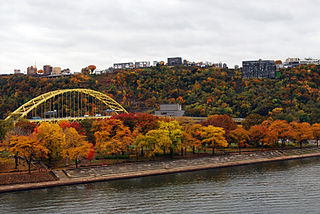
Point State Park is a Pennsylvania state park which is located on 36 acres (150,000 m2) in Downtown Pittsburgh, Allegheny County, Pennsylvania, USA, at the confluence of the Allegheny and Monongahela rivers, forming the Ohio River.
Fort Bedford was a French and Indian War-era British military fortification located at the present site of Bedford, Pennsylvania. The fort was a star-shaped log fortress erected in the summer of 1758.

The Stephen Collins Foster Memorial is a performing arts center and museum which houses the Stephen Foster Archives at the University of Pittsburgh in Pittsburgh, Pennsylvania, USA. It is dedicated to the life and works of American songwriter Stephen Foster.

The William Pitt Union, which was built in 1898 as the Hotel Schenley, is the student union building of the University of Pittsburgh main campus, and is a Pennsylvania and Pittsburgh History and Landmarks Foundation Historic Landmark.
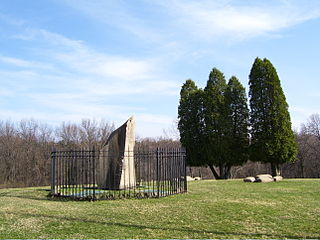
Bushy Run Battlefield Park is a historical park that is operated by the Pennsylvania Historical and Museum Commission (PHMC) and the Bushy Run Battlefield Heritage Society on 218 acres (88 ha) in Penn Township, Westmoreland County, Pennsylvania in the United States. It was the site of the Battle of Bushy Run fought on August 5–6, 1763 during the Pontiac's Rebellion. The battle was a major victory for the British and enabled them to secure their control of the Ohio River Valley and what was to become the Northwest Territory. Bushy Run Battlefield Park was established as a Pennsylvania State Park in the 1920s and became a National Historic Landmark in 1960. The Visitor Center is open Wednesday through Saturday from 9:00 am until 5:00 pm, and Sunday from noon to 5:00 pm, during the months of May–October. The Visitor Center hosts a museum exhibit entitled, "The March to Bushy Run", a theater, a gift shop and battlefield tours. Bushy Run Battlefield Park is the only historic site or museum that deals exclusively with Pontiac's Rebellion. Battle reenactments are held annually on the first full weekend of August. The park is on Pennsylvania Route 993 near Harrison City and Jeannette.

Fort Pitt Museum is an indoor/outdoor museum that is administered by the Senator John Heinz History Center in downtown Pittsburgh, Allegheny County, Pennsylvania in the United States. It is at the confluence of the Monongahela and Allegheny Rivers, where the Ohio River is formed. Fort Pitt Museum is surrounded by Point State Park, a Pennsylvania state park named for the geographically and historically significant point that is between the rivers. This piece of land was key to controlling the upper reaches of the Ohio River Valley and western Pennsylvania, before, during and after the French and Indian War as well as the American Revolution.
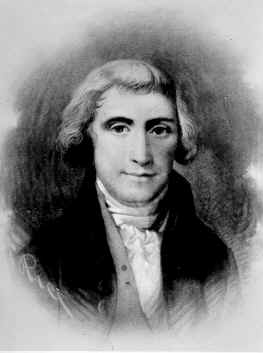
James O'Hara (1752?–1819) was an American military officer, businessman, and captain of early industry in Pittsburgh, Pennsylvania, United States.

The Henry Clay Frick Fine Arts Building is a landmark Renaissance villa and a contributing property to the Schenley Farms-Oakland Civic Historic District on the campus of the University of Pittsburgh in Pittsburgh, Pennsylvania, United States. The Frick Fine Arts Building sits on the southern edge of Schenley Plaza, opposite The Carnegie Institute, and is the home of Pitt's History of Art and Architecture Department, Studio Arts Department, and the Frick Fine Arts Library. Before its front steps is Mary Schenley Memorial Fountain.

The Panther Hollow Bridge is an American steel, three-hinged, deck arch bridge that carries Panther Hollow Road over Panther Hollow in Schenley Park in Pittsburgh, Pennsylvania.
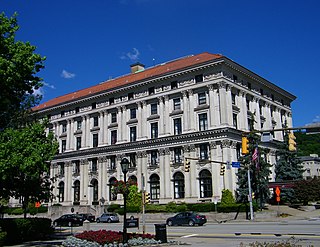
The Pittsburgh Athletic Association was a private social club and athletic club in Pittsburgh, Pennsylvania, USA. Its clubhouse is listed on the National Register of Historic Places.

Bellefield Hall is a Pittsburgh History and Landmarks Foundation Historic Landmark and is a contributing property to the Schenley Farms Historic District on the campus of the University of Pittsburgh across Bellefield Avenue from Heinz Memorial Chapel and the lawn of the university's Cathedral of Learning in Pittsburgh, Pennsylvania, USA. A 1924 italianate structure by architect Benno Janssen, it originally served as a Young Men's and Women's Hebrew Association, but now houses rehearsal spaces, classrooms, offices, and a Digital Recording Studio for the University of Pittsburgh's Department of Music, as well as a university gymnasium, fitness center, indoor swimming pool, and a 676-seat auditorium.
Boquet is an unincorporated community in Penn Township, Westmoreland County, Pennsylvania, United States.

The O'Hara Student Center, formerly the Concordia Club, is a three-story, 18,000-square-foot (1,700 m2) building on the campus of the University of Pittsburgh on O'Hara Street in the Oakland neighborhood of Pittsburgh, Pennsylvania. It is a contributing property to the Schenley Farms National Historic District and the City of Pittsburgh Oakland Civic Center Historic District. The building was acquired by the university in mid-December, 2009. and has since been renovated to house academic and student activity programs.
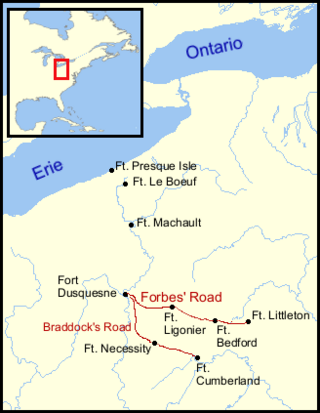
The Forbes Road, a historic military roadway in what was then British America, was initially completed in 1758 from Carlisle, Pennsylvania, to the French Fort Duquesne at the junction of the Allegheny and Monongahela rivers in what is now downtown Pittsburgh, via Fort Loudon, Fort Littleton, Fort Bedford and Fort Ligonier. The road, initially about 220 miles long, was named for Brigadier General John Forbes, the commander of the 1758 British-led expedition that built the road during the French and Indian War. The Forbes Road and Braddock's Road were the two main land routes that the British cut west through the wilderness during the war. The task was complicated by the Appalachian Mountains' steep northeast-to-southwest ridges, a generally broken terrain between the ridges, heavy forestation, and numerous swamps and rivers.
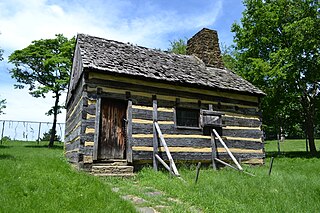
The Neal Log House is a historic log cabin built in 1765 in Pittsburgh, Pennsylvania. The Neal Log House is the oldest existing residential structure in Pittsburgh and one of the last few buildings left from the eighteenth century. The two other buildings - the Old Stone Inn, 1756 and The Fort Pitt Block House, 1764 are not residential structures. The Pittsburgh History and Landmarks Foundation placed a Historic Landmark Plaque on the building in 1970. In 1977, it was named a City of Pittsburgh Designated Historic Structure. It is part of Schenley Park U.S. Historic District The house was originally called the "Neal Log House" which is the predominant spelling of the family’s name. However in various documents the last name was spelled Neil and on one document Neill. In 1969 Charles Covert Arensberg wrote a paper entitled "The spelling of Robert Neill who built the Neill Log House in Schenley Park". It is now known that Arensberg made several erroneous assumptions about the spelling of the last name. Unfortunately the 1969 paper was used to submit to the city to change the name from "Neal" to "Neill" in spite of the fact the most common spelling of the family’s name was "Neal". [6].

The Pittsburgh Renaissance Historic District is a historic district in the Central Business District of Pittsburgh, Pennsylvania, United States. It was listed on the National Register of Historic Places on May 2, 2013.



